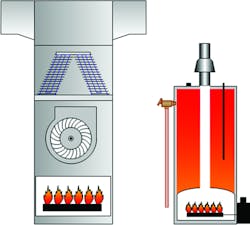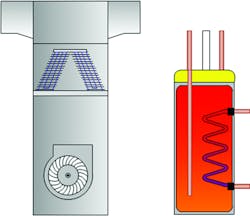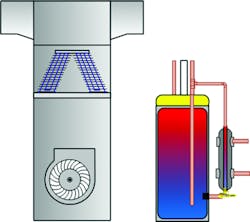It’s a “Horse Apiece:” Radiant and forced air in the same room
The English language has some very peculiar locutions (a big word for expressions — feel free to use the word “locutions” at your next party). We use them every day, and people seem to know what they mean, but when you stop and analyze what people are really saying, you scratch your head: “What does that mean?”
An expression that comes to mind is, “Cat got your tongue?” Now, what in the world does that mean? I don’t think that a cat has opposing thumbs capable of grabbing your tongue in the first place. And why would you let a cat get inside your mouth to grab your tongue to begin with?
“Kick the bucket” is another common phrase that makes no sense at all. What does kicking a bucket have to do with dying? Why would you want to “butter someone up?” And just for shear shock value, how about the phrase “Don’t throw the baby out with the bathwater?” That conjures up a nightmare scenario, doesn’t it?
Which brings us to the title of this article, “It’s a horse apiece,” a phrase used to compare two things that are nearly equal. It is very similar to the phrase, “six of one, half dozen of the other.” However, in this case, I actually know the origin of the phrase. I grew up in Montana, and back in the 1960s they used to play a bar drinking game to pass the time called “horse.” It involved five dice and you threw the dice to make the best poker hand with a maximum of three rolls. (The number ones on the dice were wild.)
Whoever had the highest hand would win the round. You’d play three rounds total, and whoever lost had to buy a round for everyone else. A loss was called a “horse,” and someone would say, “It’s a horse on you.” So, if you were tied with someone at the end of two rounds, “It’s a horse apiece.” The saying eventually came to mean any two things that were approximately equal. Which brings us to the title of this article.
The real problem with radiant
I recently received an email in response to an article that I had written for CONTRACTOR, titled “Failure to Launch—The Story of Radiant Heating.” The reader had some good thoughts, but concluded that the real problem with radiant heating and why it still is not growing in market share is that you still have to install another system on top of the air conditioning to do the heating. So you have one system to cool air and another system to heat water. It’s the dreaded two-system argument.
Raise your hand if you’ve heard that argument before. If there is one pushback about radiant heating that is more prevalent, more terminal than this one, I can’t imagine what it would be. Despite the obvious benefits of radiant across a whole spectrum of reasoning, the main reason it is not gaining market share for houses under 3,000-sq.ft. is the undeniable reality that in order to have both heating and cooling, a radiant system requires two systems in the mechanical room. With a forced-air unit, you only need one.
If there is one pushback about radiant heating that is more prevalent, more terminal than this one, I can’t imagine what it would be.
The fact that it is more energy-efficient, more quiet, more comfortable and less impactful for indoor air quality, it is still a two-system installation; therefore, it’s too expensive. I suppose you could make the argument that you could install radiant cooling and then you would only have one system again, but what about the humidity? The latent heat? You’d still need a whole-house dehumidifier. Back to two systems in the mechanical room. So, case closed. End of discussion.
Alas, the reader was correct.
But just for the sake of argument (yet another locution that doesn’t make sense), I’d like to throw another thought into the ring. I contend that with a forced-air system, there are already two systems in the mechanical room. There is the furnace that serves the dual purpose of both heating and cooling the air, and there is a second system — the water heater. By far, the majority of homes under 3,000-sq.ft. have both a furnace and a water heater in the mechanical room. The furnace is heating and cooling air and the water heater is heating water. Voilà — two systems. A horse apiece.
So now, if we take the heating out of the furnace and put it in the water heater, we still only have two systems. When we take the heater out of the furnace, they no longer call it a furnace. A better description would be a vertical fan coil unit. This unit has all the air-conditioning equipment, dehumidification and blowers that a furnace has, but does not have a burner for the heat. So, you still have the vertical fan coil unit with the a-coil for the air conditioning to do your cooling and dehumidifying, and the heating is done with a “combi-boiler.”
A combi-boiler heats potable domestic hot water in one part of the tank and hydronic non-potable boiler water in another: one appliance that does two jobs. Combi boilers are condensing boilers, so you would get a much more efficient water heater — approaching 95 percent — than the typical natural gas water heater, which delivers 55 percent to 60 percent efficiency at best. In addition, the heat is not at the bottom of the water heater, so it won’t leak out the bottom like most regular water heaters eventually do.
A 95-percent rating means a 30 percent to 35 percent increase in water-heater efficiency. Combi boilers also are available in heat-pump versions for the all-electric crowd. These also help cut carbon monoxide emissions for a greener environment. Some of these newer combi heat pumps have COP (coefficient of performance) ratings in the high teens, so they are extremely inexpensive to run. In many cases, they can compete with natural gas prices.
What would it look like?
Figure 1 shows a mechanical room with a standard furnace for heating and cooling air and a water heater.
Figure 2 shows a mechanical room with a vertical fan coil unit for cooling the air and a combi boiler to heat the domestic hot water and the radiant water as well. As you can see, they have the same footprint in both of the mechanical rooms.
It’s a horse apiece!
Figure 3 shows yet another option: a vertical fan coil unit for the air conditioning and a standard condensing boiler with a side-arm coil. Again, the same footprint in both: a horse apiece!
What about the cost?
There was a cost reduction in switching from a furnace to a fan coil unit and eliminating the water heater. But we must add the costs of a.) the combi-boiler and b.) the installation of the radiant tubing, pumps, expansion tank, air eliminations and additional controls, etc. I got some prices from a friend of mine in the wholesale business, and I know what the approximate labor costs are for a radiant installation job — using best piping practices, of course. It came out to be an additional $8,700.
- Amortizing that over 30 years, at 4 percent interest, calculates to an additional $41.50 per month on a mortgage bill.
- Using Department of Energy figures for the savings of a radiant system instead of a forced air system plus the energy saved from the water heater — with an average energy bill of $2,100 per year — the savings would be $52.50 per month.
The bottom line: I could have the heating system of my dreams, in the same mechanical room footprint, and save $11 per month.
The new system is not costing a penny — quite the opposite. And it’s not taking up any more space. That sounds like a horse apiece to me!
I would encourage you to find and compare your own prices for these systems, because prices will vary, depending on locale and the equipment you use. To calculate the interest rate, use: $4.21/$1,000 at 3%, $4.77/$1,000 at 4%, and $5.37/$1,000 at 5%.
One of the side benefits of installing a cooling fan coil unit with a combi boiler is that if you zoned the air conditioning correctly, you could have heating in some parts of the house while you are cooling others. How’s that for a side benefit? That’s not a horse apiece — it’s a better horse!
As always, I would be grateful to hear your thoughts, ideas and stories. Until then, best regards and happy heating!
Steve Swanson is the national trainer at Uponor Academy. He actively welcomes reader comments and can be reached at [email protected].
About the Author
Steve Swanson
Steve Swanson is the customer trainer at Uponor Academy. He actively welcomes reader comments and can be reached at [email protected].



